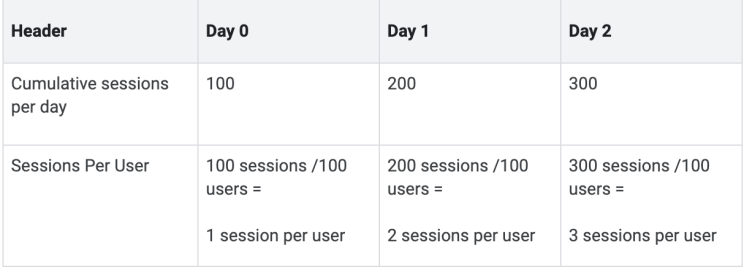LTV from Google Analytics vs LTV provided by Littledata
Google Analytics’ approach to calculating LTV is more of an estimation per user, while Littledata provides you the most accurate calculation you can get when it comes to LTV.
Our approach to LTV calculation is the sum of all purchase value by an individual customer.
We made a comparison below of how LTV is calculated in Google Analytics versus Littledata's approach to calculating this metric.
How the metric is calculated in Google Analytics
This report presents the data as the cumulative average value per user per the time increment you are using (day, week, month). For example, if you are evaluating Sessions per User on a daily basis, then the report shows you one value per day that represents the average number of sessions per user.
Lifetime value is calculated using the cumulative sum of the metric value divided by the total number of users acquired during the acquisition date range. For example, if you acquired 100 users during the acquisition date range, then Sessions Per User is calculated as follows:

You can examine conversions (transactions, goal completions), revenue, and behavior (sessions, session duration, app views).
As you see, Google Analytics’ approach is not the most accurate one - it tries to estimate the LTV. This is basically a workaround and gives you a rough estimate when no other options are available.
What are the limitations of the calculations in Google Analytics?
One major limitation is that you have a window of only 90 days starting with the date of acquisition. This limits you to see the LTV for up to 90 days.
The LTV will be displayed on a user level. While this is a good start, it does not answer the question of how much revenue a business makes per Customer.
How Littledata calculates the LTV
Littledata takes a different approach to calculating LTV. Based on the CustomerID from Shopify, we aggregate all the users' unique purchase value. The LTV will be the sum of all their purchase values. This means LTV value will be as accurate as it can be.
Benefits and differences:
Extended window :
While in Google Analytics you have a 90-day window to look at the LTV, using Littledata’s LTV data points, you can go back from the point you started using Littledata. Our long term clients benefit from more than 2 years worth of LTV data. This is highly valuable, especially for a subscription business.
LTV by Customer:
Littledata provides LTV data for each individual customer. This is the value everyone expects to know when we are talking about LTV. With each customer's LTV data known, multiple calculations can be made from cohort analysis to median LTV by channels and accurate LTV/CPA ratios.
Available from Day 1 of using Littledata:
The major benefit of using Littledata is that you will have the lifetime value of a customer, from the day you will be using our app.
Even though we don't have historical data from previous purchases, we will still be able to get the sum of all the customer purchases when the customer makes a new purchase.